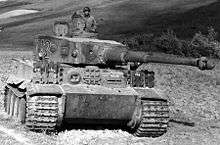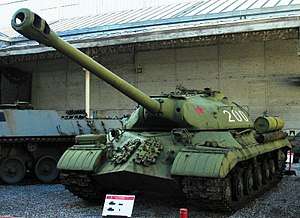Heavy tank
A heavy tank was a class of tank that generally provided better armour protection as well as equal or greater firepower than tanks of lighter classes, often at the cost of mobility, maneuverability and, particularly, expense.
| Heavy tank | |
|---|---|
 A Soviet IS-3 heavy tank | |
| Type | Tank |
| Service history | |
| In service | 1916 – ca. 1990s (early part of) |
The origins of the class date to World War I and the first tanks; designed to operate in close concert with the infantry and facing both artillery and the first dedicated anti-tank guns, early tanks had to have enough armour to allow them to survive in no man's land. As lighter tanks were introduced, the larger designs became known as heavies. A similar 'breakthrough' role remained into World War II.
As tank-v-tank combat became more common, heavy tanks mounted very powerful anti-tank guns. By the end of the war they were used both for dealing with heavy fortifications as well as antitank work. They were also known as breakthrough tanks, indicating their purpose of spearheading the attack. They were usually organised into specialised heavy tank units.
The emergence of the main battle tank spelled the end of the heavy tank as a separate class, although a number of post-war examples were produced. These were generally gone by the 1960s.
Role
Heavy tanks achieved their greatest successes both fighting other, lighter tanks, and destroying fortifications with their very large guns. Although it is often assumed that heavy tanks suffered inferior mobility to mediums, this was not always the case, as many of the more sophisticated heavy tank designs featured advanced suspension and transmission precisely to counteract this drawback. But the greatest drawback is cost which translates into production quantities and/or design. The German Tiger I, for example, had similar speed and better terrain-handling characteristics when compared to the significantly lighter Panzer IV medium tank, albeit at the cost of low reliability and only 1,355 were produced compared to 8,800 Panzer IV and over 59,000 Soviet T-34 and over 45,000 American M4 Sherman medium tanks. This case repeated itself in the operational use of the Tiger II of which only 492 were produced.
Design
Heavy tanks feature very heavy armour and weapons relative to lighter tanks. Many heavy tanks shared components from lighter tanks. For example, the US M103 shared many components with the lighter Patton tanks including its transmission and engine. As a result, they tend to be either underpowered and comparatively slow, or have engine and drive train reliability problems. In case of an entirely new design development, which was the case with the German Tiger I, the design became needlessly complex and costly, resulting in low production numbers.
History
The heavy tank concept originated in World War I and coexisted with light and medium tanks until the end of the Cold War with the introduction of the main battle tank.
World Wars

The first British tank, the Mark I of World War I, was introduced to break through German defensive lines of trenches and barbed wire. When lighter, faster tanks were introduced, the larger tanks were classified as heavy.
The Char 2C was one of the largest tanks ever produced. At the start of World War II, France and the Soviet Union were the only countries to have inventories of heavy tanks, such as the Char B1, T-35, and KV-1. The Matilda II was designed under the British infantry tank concept which is similar to the heavy tank having thick armor and weighing more than their other tanks. It’s usually separate because they have less firepower with their cruiser tanks (comparable to mediums) at the time having the same main armament but more machine guns. Later war examples were the German Tiger I and II, as well as the Soviet IS series. Note that "heavy" versus "medium" is more a question of tactical roles than weight; the Panther, for example, was a "medium" tank that outweighed most Allied "heavy" tanks.
American forces rarely fielded heavy tanks, as they still held on to the infantry-support doctrine like the British; in addition, the Americans recognized the logistical and mobility issues that came with possessing a heavy tank force and did not want to compromise its 3,000 mile supply line to Europe. As a result, the US instead preferred to use tank destroyers for anti-tank combat, and prior to 1944 there were few indications that the M4 Sherman was outclassed in terms of armor and weapons by German heavy tanks. Near the end of World War II, the M26 Pershing was sent to Europe in limited numbers, being the closest the Americans had to a heavy tank other than the up-armored M4 Sherman Jumbos.
Cold War

The immediate post-war period saw the final fielding of heavy tanks, including the US M103 heavy tank, the British FV214 Conqueror, and the French ARL 44 (in very limited numbers for the ARL 44), all in response to the Soviet heavy tanks of the period. The largest tank guns were approaching maximum calibre whose shell could still be handled by the crew, even using awkward two-part ammunition (separate projectile and propellant case, similar to battleship guns), which greatly slowed their rate of fire. Thanks to improved shell designs and fire control technology improving accuracy, postwar medium tanks were catching up to heavy tanks in firepower. The tactical value of heavy tanks thus declined to the point that no new designs were fielded; the heavily armed mediums came to be known as the main battle tank (MBT). Doctrine held that less expensive self-propelled artillery could serve in the infantry support role. The weight of MBTs quickly increased during the Cold War, and most third generation MBTs including the M1 Abrams, Challenger 2, Leopard 2, Merkava, Arjun MBT, and Type 99 have weights similar to those of 1950s heavy tanks.
Older heavy tanks with steel armour were rendered obsolete by anti-tank guided missiles and high explosive anti-tank (HEAT) ammunition. The much more flexible missiles are effective at ranges beyond a tank gun's range, and sheer armour mass was no longer a guarantee of survivability against the largest HEAT warheads of tank guns or missiles.